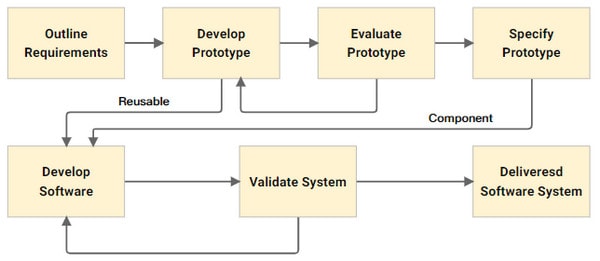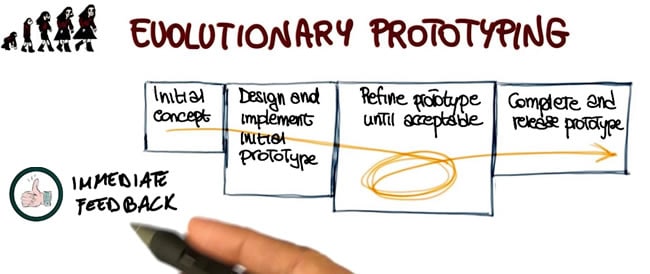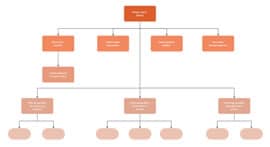Complete Guide of Throwaway Prototyping
Want to Create Throwaway Prototype? Try Now!
Wondershare Mockitt Prototype Designer realizes easy & rapid prototyping for iPhone, Android, Websites, and more. Drag and drop to create wireframes and prototypes. Give it a try!
When it comes to designing prototypes, many terms get tossed around, one of them is throwaway prototyping. The throwaway prototyping model is one of the complementary steps within developing prototypes that are used to facilitate the specific development of the prototype.
Usually, when it comes to developing prototypes, you can skip this step, but it's essential if you want your prototype to not have any defects within it. Throwaway prototyping methodology helps its users find defects within the proposed prototyping by making a makeshift prototype, especially for feedback.
With the help of throwaway prototyping models, developers can take out as many prototypes' models for the testing phase before proceeding with the other steps in developing the prototypes.
- Part 1: What is Throwaway Prototyping
- Part 2: Advantages and Disadvantages of Throwaway Prototyping
- Part 3: When to Use a Throwaway Prototype
- Part 4: Difference between Throwaway Prototyping and Evolutionary Prototyping
- Part 5: The Best Online Prototype Tool [Recommend]
What is Throwaway Prototyping
What is the throwaway prototyping methodology?
Throwaway prototyping is a part of the development of a prototype. When the prototype developers are concerned with a respective aspect of the prototype, they make throwaway prototypes to test it and get feedback from it. The end-users take the prototype, evaluate it, and provide feedback for the continuation, and addition within the developmental cycle.
Rapid throwaway prototype
The rapid throwaway prototype isn't integrated within the developmental cycle. Rather, its results are taken, and the prototype is discarded. The very nature of the throwaway prototype is the reason why it got its name.
Throwaway prototype model
The throwaway prototype model is just there to validate the system's functionalities and requirements. Once they're understood, and worked upon, throwaway prototypes are thrown away because they won't add any more advantage to the prototype.

Reducing the risk of the product is the key goal when it comes to prototyping. You can't add them within the product, because they only check one aspect of it. The whole product will have tens or even hundreds of throwaway prototypes constructed alongside the project to check if it doesn't backfire.
What is close-ended prototyping?
The other name of throwaway prototyping is close-ended prototyping. Developers create tons of prototypes, as they keep doing the actual project. They test the throwaway prototypes, implement the results in the main project, and then discard them.
This constant construction and discarding of multiple throwaway prototypes are beneficial for projects because it tests various aspects of the project. You won't have to make constant changes to the main project and test it upon multiple throwaway prototypes that you'll develop.
With the various feedback that the end-users give to the developers, this provides developers to make various changes or implementations within the project. The feedback of what the customer's needs are achieved with this special type of prototyping. The development cycle of the prototype gets longer, but it becomes exponentially efficient, and the product that turns out much better.
If you wonder how to create prototype with ease. Try Mockitt Prototype Designer to use pre-made templates and edit by yourself!
Advantages and Disadvantages of Throwaway Prototyping:
Advantages of Throwaway Prototype
Throwaway prototyping is very beneficial for developers when taking into customer feedback. Usually, developers have a problem in deploying the whole project for the customers or get the end-users to give them useful feedback. That is where throwaway prototypes step in and give a hand to the developers. There are multiple advantages of throwaway prototyping, such as:
*Cost-Effective:
As we take multiple throwaway prototypes, we can use them to test out different aspects of the project. With the deployment of so many prototypes, you can be sure that a lot of testing is going on. Usually, when testing comes up within the developmental cycle, it becomes expensive to take out all the errors and unneeded resources from the project.
The prototypes help in this regard as multiple throwaway prototypes help in detecting different problems, and these problems are thrown away, just as the throwaway prototypes as well. This reduces developers a lot of time and cost when it comes to testing. Developers don't have to roll back their products once it hits markets as well.
*Versatile:
Versatility is one of the advantages of throwaway prototypes. You can switch up the programming language within the throwaway prototype, which can be completely different from the main project. This speeds up the processing of the development, as it removes complex languages and the processing time associated with them.
You can even design throwaway prototypes that are vastly different from the project, just as long as they test the feature that concerns the purpose of the throwaway project.
*No documentation:
When it comes to throwaway prototypes, you don't have to add documentation. Whatever steps, or whatever findings are done within the developmental cycle, need documentation. This documentation is avoided because throwaway prototypes aren't considered part of the final project.
Documentation needs specifications of the project, and as throwaway prototypes are only there to test, and be discarded, so developers usually are saved from this hassle.
Disadvantages of Throwaway Prototype
Everything has its two side, so as to the throwaway prototype, here are some cons while using this prototype.
*Communication:
If one of the members doesn't make a record of the work on time, others will not know about the change and the latest process of the project. Thus, the team may have to spend lots of time to re-communicate or re-do the work.
*Visibility Issues:
To run a project on time and with more accuracy, it is better to build a specific plan than use the throwaway plan to arrange all the actions, so that teammates have to follow the plan to make sure the project can hand out on schedule.
When to Use a Throwaway Prototype
*Proof of Concept
This is usually use when you need to proof to others you have a feasibility plan, show them your implementation idea.
*Ideation and Innovation
This is used for showing innovative solutions while already starting the project. It is unreasonable to spend lots of time writing a specific plan before deciding to use it, a throwaway plan can perfectly list your idea.
*R&D
Before starting a landing plan, we need to make research to prove the plan, thus, the throwaway plan is the best prototype to show all the aspects and the possibility of the plan.
Wondershare Prototype Designer
Gives you a hand in developing and designing various prototype with your unique and original ideas. Can use-premade templates to show your ideas.
Difference between Throwaway Prototyping and Evolutionary Prototyping
- In developmental cycles, you'll come across these two terms most of the time, throwaway prototypes, and evolutionary prototypes. Both have their merits in development, and the project leader needs to decide which is needed concerning the nature of the project.
- When it comes to throwaway projects, they are primarily used for feedback. Once the use of the prototype is finished, its discarded. Developers can make tons and tons of throwaway prototypes for just one aspect of the project.
- This type of prototyping saves a lot of time for the developers, and that is why it's preferred if the developmental cycle is planned to be short. Throwaway prototyping is best utilized when multiple aspects of the projects are to be tested, along with the project, with fast end-user feedback.

- If the prototype is not viable, it is discarded. Still, if a prototype results in great feedback, its results are used within the project, but the prototype is still ultimately discarded.
- Evolutionary prototyping is the prototyping that developers will incorporate within their projects. Evolutionary prototyping is a much slower process than throwaway prototyping because every change is taken with great care.
- Developers can't just discard evolutionary prototypes, and if they do, they have to start from scratch to incorporate it. The reason evolutionary prototypes are used is that the developers want to release the whole project and see what kind of feedback their users give.
- Each prototype has its perks, and it's up to the developers to decide which prototype suits their needs.
The Best Online Prototype Tool
Wondershare Mockitt is a tool that is used to make prototypes of various digital content related platforms, such as wireframes, websites, mobile applications, etc. The application has a much variety of uses in the prototype industry, and it's steadily rising in the market. The reception from the customer base has been very warm, and developers are giving the thumbs up for the product.

Mockitt has the option of making hundreds of throwaway prototypes, that will become useful for the project. With the multiple features found within the application, the development of throwaway prototypes becomes much easier. This ease of the process of development gives many of the user's relief, which results in efficient development.
Features such as a collaborative environment help everyone in the developmental team to pitch in. With everyone giving their little touches on the prototype, it becomes a team effort. Plus, everyone can review the prototype and make subsequent changes to it.
Conclusion: With multiple platform deployment options, the throwaway prototype modeling becomes much easier. You don't have to make a prototype and be fearful if it won't run on another device. Just transfer the prototype, and voila, you have your prototype in your desired format and device.


